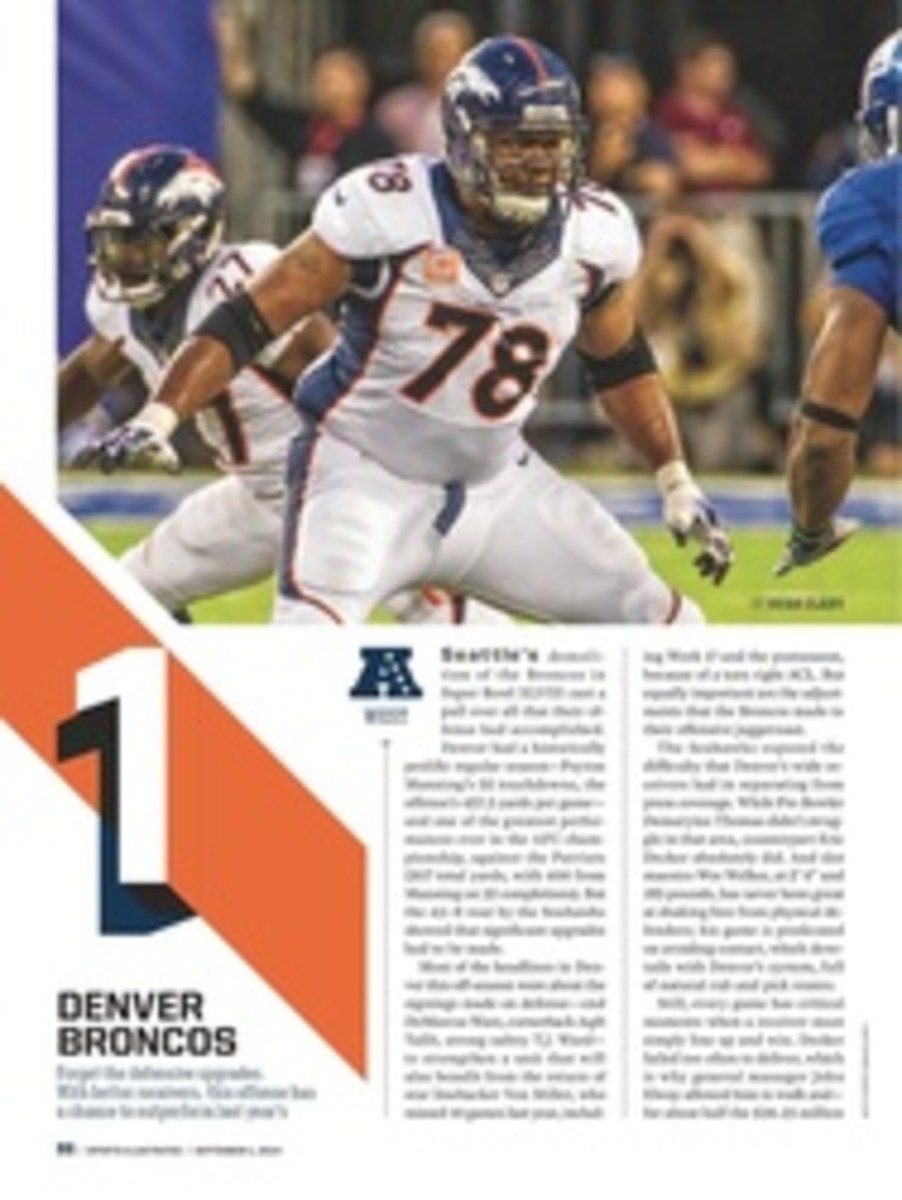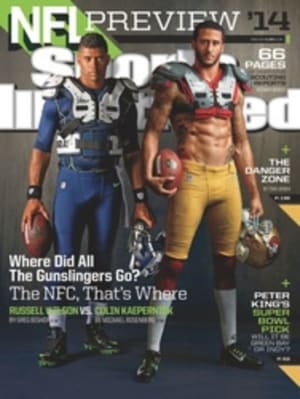
4 OAKLAND RAIDERS
The Raiders, a once-proud franchise with three Super Bowl wins in five appearances, have been in free fall for 11 years and counting because Hall of Fame owner Al Davis lost his touch. He made blunder after blunder (drafting JaMarcus Russell and throwing money at a damaged Javon Walker are among the lowlights) and had too little patience (from 2002 no coach lasted three seasons). After Davis's death in '11, the hope was that his son, Mark—who, upon inheriting the team, made it clear that, unlike his father, he's not a football guy—would bring more patience and calm to the organization.
But the Raiders' ship has been slow to right—and understandably so. When general manager Reggie McKenzie and coach Dennis Allen arrived in 2012, the team was an absolute mess. Yet even though this is only the second year they've had high draft picks to use (the Raiders had traded several from '12) and this is the first year they've had salary-cap space (they inherited more than $55 million in dead money on the books from bad signings), there's already a sense that McKenzie and Allen are fighting for their jobs.
McKenzie's roster overhaul last year created $64 million in fresh cap room headed into this off-season, though a leaguewide jump in the cap helped make at least a dozen other teams strong players in the free-agent market. If the money is equal, players choose their destination based on a team's other qualities, and that's where the Raiders, with their run-down stadium and recent performance history, lose out.
McKenzie, like his mentor, venerated Packers GM Ted Thompson, believes that quality teams are built through the draft. But with so many gaping holes to fill and pressure from ownership to show immediate improvement, he has had to sign veterans as temporary fixes. Last season he brought in nine new starters on defense. This year that same unit is getting six new starters, including four veterans signed for two years or less. None of them are marquee guys.
The offense will also have at least six and possibly eight new starters, including the man taking snaps—either 2014 second-round pick Derek Carr, from Fresno State, or 11th-year veteran Matt Schaub, cast off by the Texans. The dilemma at quarterback will carry on throughout the season and perfectly illustrates the consequences of impatient ownership. Instead of giving Carr the time he needs to develop, the coaches will feel the need to start Schaub, knowing they can't afford a third straight year of 4--12 (even if those records are a fair reflection of the personnel they were given). Because if Carr were to struggle, chances are good that the staff will have simply initiated his development for the benefit of the next regime. A "win now" (or "just win, baby" as Al liked to say) approach is often a good thing, but for a franchise unmistakably at the outset of a long rebuilding process, that attitude will undoubtedly result in more long-term mediocrity.
Regardless of who is under center, the Raiders now at least have the resources to be competitive offensively, which wasn't the case last year. Up front, the free-agent signings of left tackle Donald Penn and right guard Austin Howard will help plug what has been a porous line. Still, Penn and his new bookend, right tackle Menelik Watson, will need support in pass protection. Watson is gifted but incredibly green. At guard, utility man Khalif Barnes is likely just keeping the seat warm for rookie Gabe Jackson (Mississippi State). Whoever is there, the Raiders need more cohesive run-blocking around fourth-year center Stefen Wisniewski.
Taking advantage of that run blocking will be free-agent pickup Maurice Jones-Drew. At 29, the former Jaguar and 2011 rushing champ is not much better than the man he's replacing, departed free agent Rashad Jennings (Giants), though he will be an upgrade as a pass catcher. Fragile returnee Darren McFadden won't improve matters either; he doesn't have the lateral dexterity to create his own yards, though he can still explode downhill if given daylight.
In the passing game, free-agent wideout James Jones must go from being a No. 3 receiver in Green Bay to a No. 1 in Oakland. Jones will have some help if lanky and acrobatic playmaker Andre Holmes, 26, builds off the promise he showed in 2013. But with the rest of the receivers unable to consistently beat man coverage and the tight ends giving defenses little to fear, that's a lot of pressure on Jones and Holmes. Though it's nothing compared with the stress on the men above them.
2014 SCHEDULE
2013 Record: 4--12
WEEK 1
NYJ [AWAY]
HOU [HOME]
NE [AWAY]
MIA LONDON [HOME]
BYE
SD [HOME]
ARI [HOME]
CLE [AWAY]
SEA [AWAY]
DEN [HOME]
SD [AWAY]
KC THUR [HOME]
STL [AWAY]
SF [HOME]
KC [AWAY]
BUF [HOME]
DEN [AWAY]
WEEK 17
THE BIG FIX
The defensive front
With a collection of backups turned starters, the Raiders' defensive line last season eroded down the stretch. It wasn't the most talented group to begin with, which is why GM Reggie McKenzie has revamped it for a second straight year. To replace the departed Lamarr Houston, he signed ex-Giant defensive end Justin Tuck and ex-Steeler linebacker LaMarr Woodley to two-year deals. They may be in decline, but neither is completely washed up. More potent is 32-year-old tackle Antonio Smith, brought over from Houston to provide penetration inside. One reason the Raiders have to be so creative and aggressive with blitzes is that their O-line hasn't been intimidating anyone with its rush. Changing that requires great speed off the edge, which Tuck and Woodley don't have. Khalil Mack does, though. If the No. 5 pick out of Buffalo can excel as a third-down edge rusher, this group could give Oakland the improvement it has been seeking.
THE CASE FOR
Free safety Charles Woodson
Woodson, who is 37 and has said he is open to playing beyond this season, may no longer be the All-Pro that he was in Green Bay, but the veteran is a perfect fit for the system of Dennis Allen and coordinator Jason Tarver. Tarver, who directs most of the action, attacks offenses with blitzes from defensive backs, coverage rotations and presnap disguises, with many of the calls made on the field in response to how the offense lines up. Woodson, who can be brilliant at diagnosing plays in the box, is just the kind of versatile chess piece Tarver needs. So is hard-hitting safety Tyvon Branch, whose season-ending broken right leg in Week 2 deflated the defense last year. (Branch's replacement, Brandian Ross, was easily the worst defensive starter in the league last year; that he stayed on the field for Oakland speaks volumes about the team's lack of depth.) Then there's rookie Khalil Mack. No doubt the Raiders drafted the 6'3", 251-pound outside linebacker to line up on the edge in passing situations and revive their pass rush. But Mack, like last year's third-round pick, Sio Moore, can play in space too. In this complex scheme, it will help that one of Mack's key mentors is a future Hall of Fame defensive back.
PHOTO
JED JACOBSOHN FOR SPORTS ILLUSTRATED
QB DEREK CARR
PHOTO
PAT LOVELL/USA TODAY SPORTS
NINTEEN PHOTOS

